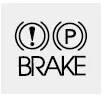Hyundai Ioniq (AE): Braking System / Parking Brake
Always set the parking brake before leaving the vehicle. To apply the parking brake:

Firmly depress the brake pedal.
Depress the parking brake pedal down as far as possible.
WARNING
To reduce the risk of SERIOUS INJURY or DEATH, do not operate the parking brake while the vehicle is moving except in an emergency situation. It could damage the brake system and lead to an accident.
To release:

Firmly depress the brake pedal.
Depress the parking brake pedal down and it will release automatically.
If the parking brake does not release or does not release all the way, have your vehicle checked by an authorized HYUNDAI dealer.
WARNING
- Whenever leaving the vehicle or parking, always come to a complete stop and continue to depress the brake pedal. Move the shift lever into P (Park) position, then apply the parking brake, and place the Engine Start/Stop button in the OFF position. Vehicles with the parking brake not fully engaged are at risk for moving inadvertently and causing injury to yourself or others.
- NEVER allow anyone who is unfamiliar with the vehicle to touch the parking brake. If the parking brake is released unintentionally, serious injury may occur.
- Only release the parking brake when you are seated inside the vehicle with your foot firmly on the brake pedal.
NOTICE
- Do not apply the accelerator pedal while the parking brake is engaged. If you depress the accelerator pedal with the parking brake engaged, warning will sound. Damage to the parking brake may occur.
- Driving with the parking brake on can overheat the braking system and cause premature wear or damage to brake parts. Make sure the parking brake is released and the Brake Warning Light is off before driving.

Check the Parking Brake Warning Light by placing the Engine Start/Stop button
to the ON position (vehicle not in the ready ( )
mode).
)
mode).
This light will be illuminated when the parking brake is applied with the Engine Start/Stop button in the START or ON position.
Before driving, be sure the parking brake is released and the Brake Warning Light is OFF.
If the Parking Brake Warning Light remains on after the parking brake is released
while the vehicle is in the ready ( )
mode, there may be a malfunction in the brake system. Immediate attention is necessary.
)
mode, there may be a malfunction in the brake system. Immediate attention is necessary.
If at all possible, cease driving the vehicle immediately. If that is not possible, use extreme caution while operating the vehicle and only continue to drive the vehicle until you can reach a safe location.
When your brake pads are worn and new pads are required, you will hear a high pitched warning sound from your front or rear brakes. You may hear this sound come and go or it may occur whenever you depress the brake pedal.
WARNING An Anti-Lock Braking System (ABS) or an Electronic Stability Control (ESC) system will not prevent accidents due to improper or dangerous driving maneuvers.
Other information:
Hyundai Ioniq (AE) 2017-2022 Service & Repair Manual: Heater Unit. Components and components location
Component Location1. Heater unit assemblyCompoents1. Heater core cover2. Heater core & Seal assembly3. Mode actuator [LH]4. Temperature control actuator [LH]5. Shower duct [LH]6. Duct sensor [Floor]7. PTC Heater8. Duct sensor [Vent]9. Heater & Evaporator lower case10.
Hyundai Ioniq (AE) 2017-2022 Service & Repair Manual: Cruise Control Switch. Repair procedures
Removal1.Disconnect the negative (-) battery terminal.2.Remove the steering wheel assembly.(Refer to Steering System - "Steering Wheel")3.Remove the steering back cover (A).4.Remove the steering remote control connector (A).5.Remove the steering remote control after loosening the screws.
Categories
- Manuals Home
- Hyundai Ioniq Owners Manual
- Hyundai Ioniq Service Manual
- Cruise Control Switch. Repair procedures
- Engine Control/Fuel System
- Repair procedures
- New on site
- Most important about car
